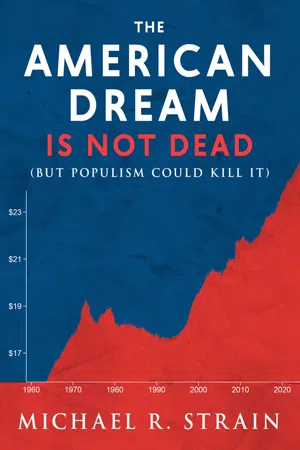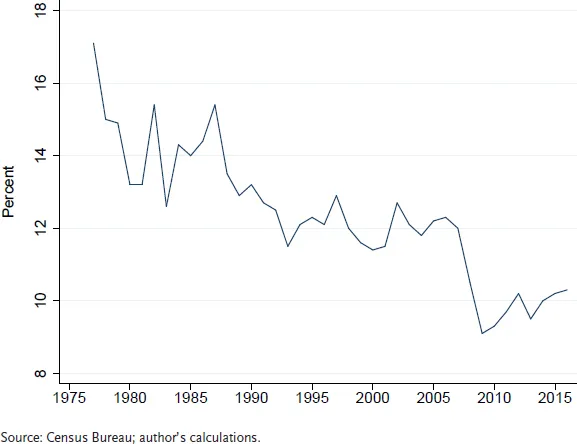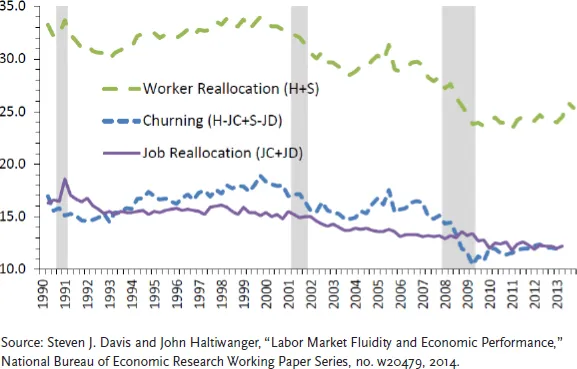![]()
PART 1
The American Dream Is Not Dead
![]()
CHAPTER 1
Defining the Dream
WHAT IS the American Dream? It means different things to different people, of course, and its meaning has changed over time. For many, individual liberty is essential to the American Dream. So is having a good family and a strong community. Homeownership is an important component, as is a comfortable retirement. (To illustrate the breadth and variety of its definition, consider that the New York Times recently asserted, “Well-manicured lawns have long been a symbol” of the American Dream.1)
My American Enterprise Institute (AEI) colleagues Samuel Abrams, Karlyn Bowman, Eleanor O’Neil, and Ryan Streeter commissioned a survey published in February 2019 that asks about the American Dream.2 Ninety-four percent of respondents reported that having a successful career was essential or important to their own view of the Dream. Eighty-eight percent reported the same about having a better quality of life than their parents.
I mention these two items because of the strong economic component at play in the American Dream. At its core, economic success is one of the most important parts of the Dream. This doesn’t mean achieving fabulous wealth, of course. Instead, it means a chicken in every pot. If you work hard and play by the rules, you can get ahead. Your effort will be rewarded. America is a place where you can build a better life for yourself and, in an economic sense, where your children will be better off than you. And in America, going from rags to riches is still possible.
This component of the Dream is the focus of this little book—not because the political and community components are unimportant—but because the economic component is so central, and—importantly—because it is the focus of today’s misguided narrative.
![]()
CHAPTER 2
Today’s Message: The Dream Is Dead
THAT MISGUIDED NARRATIVE sends a clear message: The American Dream is dead. There is no room for nuance in the message our political leaders are sending. This message is fueled in large part by an effort to understand and react to the emergence of populism in both political parties. Let’s look at a few quick examples, of many.
President Trump has been arrestingly clear on this point, stating directly, in June 2015: “Sadly, the American Dream is dead.”3 In May 2016, Senator Bernie Sanders said, “American workers are some of the most overworked yet our standard of living has fallen. For many, the American Dream has become a nightmare.”4
In a December 2018 essay in The Atlantic, Senator Marco Rubio wrote, “There was once a path to a stable and prosperous life in America that has since closed off. It was a well-traveled path for many Americans: Graduate from high school and get a job, typically with a local manufacturer or one of the service industries associated with it and earn enough to support a family. The idea was not only that it was possible to achieve this kind of success, but that anyone could achieve it—the American Dream. That dream defines my family’s history, and its disappearance calls me to action today.”5
In the spring of 2015, Senator Elizabeth Warren and Mayor Bill de Blasio wrote, “Across generations, Americans shared the belief that hard work would bring opportunity and a better life. America wasn’t perfect, but we invested in our kids and put in place policies to build a strong middle class. We don’t do that anymore, and the result is clear: The rich get richer, while everyone else falls behind. The game is rigged, and the people who rigged it want it to stay that way.”6
While giving the commencement address at The King’s College in the spring of 2019, freshman U.S. senator Joshua Hawley, Republican from Missouri, told graduates that “if you don’t have family wealth, and if you don’t have a four- year degree—and that’s 70 percent of Americans. Seventy percent—the future is far less glowing. These Americans haven’t seen a real wage increase in thirty years.”7
This pessimistic view is pervasive, and it extends to commentators, public intellectuals, and business leaders. For example, Fox News host Tucker Carlson declared in January 2019 that “the American Dream is dying,” and referred to “the dark age that we are living through.”8 The economist Joseph Stiglitz, Nobel laureate and former chair of the Council of Economic Advisers, recently wrote that “the American economy is failing its citizens.”9 Ray Dalio, the billionaire founder of investment firm Bridgewater Associates, wrote a long essay posted on LinkedIn in the spring of 2019, critiquing American capitalism and offering reforms. When discussing the essay on 60 Minutes, Dalio was as blunt as these elected leaders and presidential candidates: “I think the American Dream is lost.”10
The American Dream is not lost.
![]()
CHAPTER 3
We Have Real Challenges
BUT THIS is not to say that we don’t face real challenges. Of course we do—in our politics, economy, and culture. Political polarization, tribalism, and excessive partisanship are very real and damaging. The emergence of the political entertainment establishment reduces politics of its seriousness, often misinforms the public, and inflames passions in a way that is destructive.
The rate at which prime-age men participate in the workforce has been falling for decades (figure 1). The participation of prime-age women has stagnated over the past two decades and seems in danger of declining as well. This is deeply troubling. Its macroeconomic implications are significant: A workforce that isn’t growing will depress the growth of household income and living standards. On a social level, men without work are often men up to no good. Joblessness is correlated with crime, incarceration, and idleness. And for many individuals, a lack of employment makes it harder to be a good father and to get and stay married. For many, work is about more than a paycheck. It is how we contribute to society—and, importantly, how we can (correctly) be made to feel that we are contributing. It is a cure for boredom, which is one of the worst parts of life in a safe, modern, comfortable society. Work creates community. It emancipates us from our passions by directing them to productive ends.
FIGURE 1. PRIME-AGE LABOR FORCE PARTICIPATION RATE.
Properly understood, work is deeply spiritual. Pope John Paul II wrote that man is “called to work.” “Man is the image of God,” wrote the late Pope, “partly through the mandate received from his Creator to subdue, to dominate, the earth. In carrying out this mandate, man, every human being, reflects the very action of the Creator of the universe.” John Paul pointed out that we find “in the very first pages of the Book of Genesis” the “conviction that work is a fundamental dimension of human existence on earth.”11
Our economic challenges are hardly limited to workforce participation. Technological advances and the automation of job tasks have been changing the labor market in significant ways for several decades and will continue to do so. This change has proven to be very disruptive and will likely be more so in the years ahead. Our schools are not up to the challenge of imparting skills that allow young people to command high wages in the twenty-first-century economy. Globalization has presented challenges to some towns and communities as well, which, along with automation, has reduced employment opportunities in some formerly prosperous locales.
In addition to adding workers, the other way to grow living standards over time is through increases in worker productivity. And productivity growth has been lackluster for many years.
These challenges have all received quite a lot of attention, so I won’t dwell on them here. Let me mention one that hasn’t gotten its due. Troublingly (and not just because they are likely contributing to slower productivity growth), business dynamism and entrepreneurship have been on the decline as well, and labor markets have become less fluid.
FIGURE 2. STARTUP RATE FOR PRIVATE U.S. FIRMS IN THE NONFARM SECTOR.
The U.S. economy has been successful at generating economic opportunity in part because it has been successful at moving capital and workers to their most productive use. But business startups have been declining for years (figure 2). This is significant because young firms are a key driver of job creation and innovation.
The reallocation of workers across jobs often reflects career advancement and can improve the quality of the match between workers and firms, which increases workers’ skills, productivity, and wages. The reallocation of jobs across businesses is another important indicator of fluidity and dynamism. Economists John Haltiwanger and Steven J. Davis document that both have been in decline for the last two decades (figure 3).
FIGURE 3. QUARTERLY RATES OF JOB REALLOCATION, WORKER REALLOCATION, AND CHURNING FOR THE U.S. NONFARM PRIVATE SECTOR, 1990Q2 TO 2013Q4.
There are downsides to labor market dynamism, of course. And there can be benign and even positive effects of reduced dynamism. But I am troubled by these trends. Reduced fluidity suppresses productivity growth and wages and may even reduce overall employment.12 These trends seem to be related to an overall reduction of restlessness and energy in American life. This manifests itself, for example, in a decline in people’s willingness to pack up the car and move to a new city, and in the general sense that as a society we have become more risk averse. And it exacerbates economic disparities between regions of the country—specifically, between booming coastal urban centers and struggling rural and industrial areas. These regional disparities have animated and inflamed populist sentiment.
My intention is not to provide an exhaustive accounting of the economic challenges facing the United States, but instead to highlight several about which I am particularly concerned, and to make clear that we do face serious and difficult issues.
The same is true in American culture and social life. Robert Putnam, the Social Capital Project—an initiative of the Joint Economic Committee of the U.S. Congress started by Senator Mike Lee and led by social scientist Scott Winship—and my AEI colleagues Charles Murray, Tim Carney, Ryan Streeter, and Yuval Levin are just a few of many analysts and ...







